Since 1909, America, the “National Catholic Weekly,” has been widely known as a place where readers both in print and online can look for a smart Catholic take on events of the day. What is less well known is during those same years America has regularly published a great many articles on more overtly spiritual matters. In other words, the editors and writers have turned their attention not simply to current events, but to timeless ones.
And now a new book, Praying with America: One Hundred Years of Encountering God in Prayer with America Magazine, brings together the best of America’s writings on a particular topic: prayer.
Prayer can be a difficult topic to write about, since trying to explain it is something like trying to pin down a butterfly. The more you seek to capture it, the more it wants to escape. In the end, what happens in prayer is incommunicable, as it happens between one person and God. Even the greatest and most articulate of saints have struggled to communicate not only how they pray, but what happens when they do. Often they resort to metaphors that even they admit fail.
On the other hand, prayer is beyond no person. Everyone can pray. God desires to enter into relationship with everyone, and one need not be a cloistered mystic to enjoy the fruits of prayer.
And so, as the editors have realized since 1909, part of America’s mission is to help people to encounter God, and so to help them encounter God, we are invited to help them to pray.
Readers of the new book will notice right away how those efforts have changed over the years. Earlier articles are filled with more flowery language than the modern reader may be used to. Likewise, there is in general in the earlier works a more elevated way, as was the custom of the time, of referring to the object and source of our prayer: not “Jesus” but “Christ Our Lord,” not “God” but “Almighty God.” (And here’s a warning for anyone allergic to non-inclusive language: get ready for a lot of “Hims.”) One can also see a gradual shift, after the Second Vatican Council, in favor of a greater degree, of—for want of a better word--relaxation around the topic of prayer. Prayer becomes not so much something that one must do, as something that one is invited to do.
Otherwise, much has not changed. The emphasis on trying one’s best to pray no matter what the circumstance, the focus less on self and more on God, and the flexibility that has always marked Jesuits and their colleagues, are evident in almost every article.
Several authors take their cue from the Jesuit or “Ignatian” traditions of prayer, that is, those based on the writings, practices and traditions of St. Ignatius Loyola, the 16th-century founder of the Society of Jesus. Many authors make reference to the Spiritual Exercises, the now-classic manual for a four-week retreat written by St. Ignatius. In the Exercises, Ignatius frequently encourages the retreatant to imagine himself or herself within a Gospel scene, as one progresses through the life of Christ, with as much vividness as possible. So you will see frequent references to some aspects of the Exercises.
Several writers seem to be making a case for one form of prayer over another. So perhaps this is a good time to remind readers that there is no “best” way of prayer. Whatever works best for you is the best way of prayer. Some may enjoy Ignatian contemplation, others the Rosary, others Centering Prayer, others the examination of conscience. The Mass of course is the “source” and “summit” of Catholic prayer, as Vatican II reminded us, but in addition to the Mass it is important for believers to try a variety of ways to pray, in order to get a taste of a particular practice, and to try them at different point in one’s life, since one’s spiritual tastes may change. But any way that you choose to relate to God is worthwhile.
Think of prayer, as one of our writers, William A. Barry, S.J., likes to say, as a “personal relationship.” Friends often relate to one another in different ways—some like to take long walks, some like to see movies together, some like to have cups of coffee in one another’s home, some like to talk on the phone, and so one. At some point every relationship needs intimate, one-on-one time. This intimate, one-on-one time with God is called prayer.
But there are many ways to pray.
Also, remember that prayer may not always seem “rich.” As many writers admit in this collection, sometimes prayer seems “dry.” This is simply part of the spiritual life. In the end, however, no time spent in the presence of God is ever wasted. For any time spent in the presence of God is transformative.
One final note: Much of this new book—the selection of the articles, the editing and the grouping under the various chapters—is the work of Joseph McAuley, an assistant editor at America magazine. His quiet, tireless, humble work on this manuscript was a kind or prayer itself. Thanks also to Tim Reidy, executive editor, and Ashley McKinless, assistant editor for all their help on this volume.
On behalf of the editors of America, I would like to welcome you into this treasury of writings by authors who have graced our pages and our website. We hope that this little book helps you to pray. We ask for your prayers. And we promise you ours.
This essay was excerpted from the Introduction of Praying with America, which is available through Loyola Press and wherever books and ebooks are sold (including Amazon and Barnes & Noble.)








